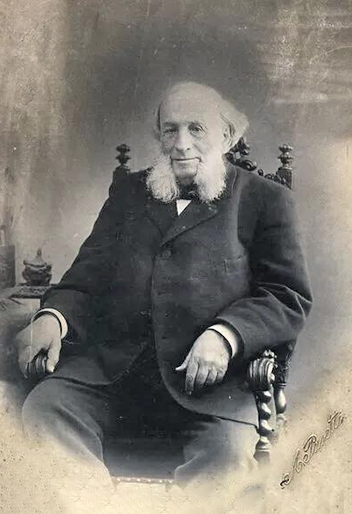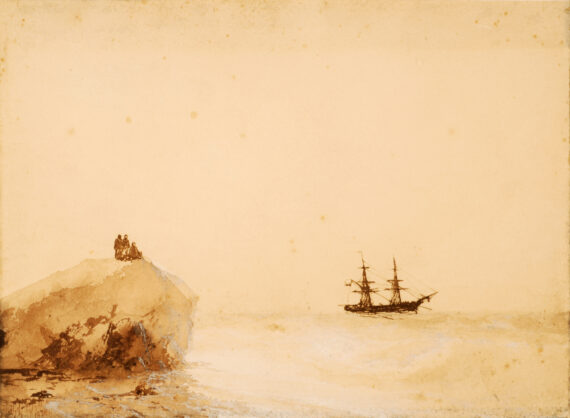IVAN AÏVAZOVSKI (1817–1900)
The Farewell. 1874
IVAN AÏVAZOVSKI (1817–1900)
The Farewell. 1874
190mm x 290mm
Black ink and watercolour on tinted paper. Signed in Armenian bottom left. Dated 1874.
 Ivan Konstantinovich Aïvazovski was born in Theodosia (Feodosia, Ukraine) in Crimea in 1817, on the northern shore of the Black Sea which inspired his fascination for water, but which he never painted from life. His father, Guevork (Constantine) and his mother Hripsime, traders from Moldavia, for practical reasons added the ending "ovski" to the family name Aïvazian, which at that point included three boys and two girls.
He displayed a gifted for the violin and for drawing from a very early age. After his elementary education at the local town school, the Mayor, A. Kaznachev, helped him to enroll at high school in Simferopol, the big city 150 km to the west, in the centre of the Crimean peninsula.
He then completed artistic training at the Academy of Fine Arts of Saint Petersburg. On completing his studies in 1837, he was awarded a Gold Medal from the Academy as well as a scholarship for further study abroad. Before leaving, however, he was commissioned by the Academy to paint the cities of the Crimean coast.
He finally left for Italy in 1840.
Naples, Rome, Florence and Venice were sources of inspiration, and he set up his easel in each of these cities producing more than fifty large-sized paintings. His works caused a sensation and he was invited to meet Pope Gregory XVI.
He travelled throughout Europe for four years and returned a member of the Academies of Rome, Paris and Amsterdam.
He was 27 years old on his return when he was appointed the official painter of the Russian Navy in 1844. He conscientiously carried out this duty producing a series of paintings glorifying its victories.
As a marine painter, he painted fictional scenes. Above all, his work had a dreamlike quality and he displayed a poetic perception of nature.
Always carried out at the studio, his highly perfected technique gave a free rein to his imagination. The transparencies he created immerse the sky and the sea into unfathomable worlds. With breathtaking skill he enhanced the light with the same fine and translucid fluidity that fascinated William Turner, the inspiration of the Impressionists.
In 1845, upon his return to his hometown of Theodosia, he built his house-studio, which would become his museum. In the same year he went to Istanbul for the first time, where he met the Patriarch Matteos II.
His comparatively isolated situation distanced him from the "democratic realism" artistic movement that was emerging in the Russian plastic arts towards the second half of the 19th century.
He nevertheless returned to Istanbul several times, in 1857, 1858 and 1874.
He was still in Theodosia when the Crimean War broke out; it lasted from 1853 to 1856. During this period he organized an exhibition of his paintings in the besieged city of Sebastopol. Glorifying Russian resistance, his paintings became so famous that even his enemies paid him tribute, Ffollowing the example of Napoleon III who made him a Chevalier de la Légion d'Honneur [Knight of the Legion of Honour] in 1857, the same year he held his solo exhibition in Paris.
He returned three times to Paris, which he loved, in 1879, 1887 and 1890. He met, among others, Eugène Delacroix (1798-1863), Gustave Doré (1832-1883) and Sarah Bernhard (1844-1923).
He went several times to the island of San Lorenzo opposite Venice, to visit his brother Gabriel Ayvazian who was part of the Mekhitarist Congregation.
He could express himself as well in Armenian as in Russian and also published several works under the name of "Hovhannes Aïvazian."
In 1868 he travelled across the Caucasus, very attached to his roots.
In 1869 he exhibited in Tiflis, now known as Tbilisi, the capital of Georgia. This was the first time that a painting exhibition had been held in a provincial city of the Russian Empire.
He tried every possible means of drawing the world’s attention to the atrocities suffered by his fellow countrymen during the 1890s in the Ottoman Empire and, in particular, painted the “Massacre of Armenians in Trebizond in 1895.” His paintings were exhibited in Moscow in 1898 for the benefit of the victims.
He took part in many other humanitarian actions, in particular to prevent the famines which were raging across certain regions of Russia towards the end of the 19th century.
He distributed his personal wealth to his fellow citizens of Theodosia, where he died in 1900.
On his tombstone in the Armenian church of Saint-Serge, the following is engraved in Armenian: “He is mortal but he has left an immortal memory.”
Ivan Konstantinovich Aïvazovski was born in Theodosia (Feodosia, Ukraine) in Crimea in 1817, on the northern shore of the Black Sea which inspired his fascination for water, but which he never painted from life. His father, Guevork (Constantine) and his mother Hripsime, traders from Moldavia, for practical reasons added the ending "ovski" to the family name Aïvazian, which at that point included three boys and two girls.
He displayed a gifted for the violin and for drawing from a very early age. After his elementary education at the local town school, the Mayor, A. Kaznachev, helped him to enroll at high school in Simferopol, the big city 150 km to the west, in the centre of the Crimean peninsula.
He then completed artistic training at the Academy of Fine Arts of Saint Petersburg. On completing his studies in 1837, he was awarded a Gold Medal from the Academy as well as a scholarship for further study abroad. Before leaving, however, he was commissioned by the Academy to paint the cities of the Crimean coast.
He finally left for Italy in 1840.
Naples, Rome, Florence and Venice were sources of inspiration, and he set up his easel in each of these cities producing more than fifty large-sized paintings. His works caused a sensation and he was invited to meet Pope Gregory XVI.
He travelled throughout Europe for four years and returned a member of the Academies of Rome, Paris and Amsterdam.
He was 27 years old on his return when he was appointed the official painter of the Russian Navy in 1844. He conscientiously carried out this duty producing a series of paintings glorifying its victories.
As a marine painter, he painted fictional scenes. Above all, his work had a dreamlike quality and he displayed a poetic perception of nature.
Always carried out at the studio, his highly perfected technique gave a free rein to his imagination. The transparencies he created immerse the sky and the sea into unfathomable worlds. With breathtaking skill he enhanced the light with the same fine and translucid fluidity that fascinated William Turner, the inspiration of the Impressionists.
In 1845, upon his return to his hometown of Theodosia, he built his house-studio, which would become his museum. In the same year he went to Istanbul for the first time, where he met the Patriarch Matteos II.
His comparatively isolated situation distanced him from the "democratic realism" artistic movement that was emerging in the Russian plastic arts towards the second half of the 19th century.
He nevertheless returned to Istanbul several times, in 1857, 1858 and 1874.
He was still in Theodosia when the Crimean War broke out; it lasted from 1853 to 1856. During this period he organized an exhibition of his paintings in the besieged city of Sebastopol. Glorifying Russian resistance, his paintings became so famous that even his enemies paid him tribute, Ffollowing the example of Napoleon III who made him a Chevalier de la Légion d'Honneur [Knight of the Legion of Honour] in 1857, the same year he held his solo exhibition in Paris.
He returned three times to Paris, which he loved, in 1879, 1887 and 1890. He met, among others, Eugène Delacroix (1798-1863), Gustave Doré (1832-1883) and Sarah Bernhard (1844-1923).
He went several times to the island of San Lorenzo opposite Venice, to visit his brother Gabriel Ayvazian who was part of the Mekhitarist Congregation.
He could express himself as well in Armenian as in Russian and also published several works under the name of "Hovhannes Aïvazian."
In 1868 he travelled across the Caucasus, very attached to his roots.
In 1869 he exhibited in Tiflis, now known as Tbilisi, the capital of Georgia. This was the first time that a painting exhibition had been held in a provincial city of the Russian Empire.
He tried every possible means of drawing the world’s attention to the atrocities suffered by his fellow countrymen during the 1890s in the Ottoman Empire and, in particular, painted the “Massacre of Armenians in Trebizond in 1895.” His paintings were exhibited in Moscow in 1898 for the benefit of the victims.
He took part in many other humanitarian actions, in particular to prevent the famines which were raging across certain regions of Russia towards the end of the 19th century.
He distributed his personal wealth to his fellow citizens of Theodosia, where he died in 1900.
On his tombstone in the Armenian church of Saint-Serge, the following is engraved in Armenian: “He is mortal but he has left an immortal memory.”
Frédéric Fringhian
